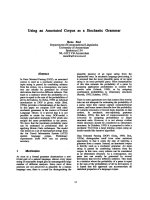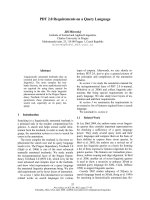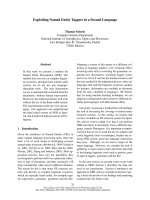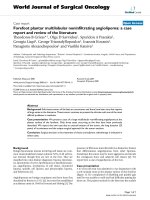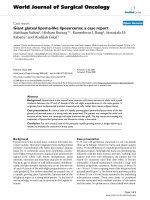báo cáo khoa học: "Cerebral amyloidoma mimicking intracranial tumor: a case report" ppt
Bạn đang xem bản rút gọn của tài liệu. Xem và tải ngay bản đầy đủ của tài liệu tại đây (754.99 KB, 3 trang )
CAS E REP O R T Open Access
Cerebral amyloidoma mimicking intracranial
tumor: a case report
Danny Landau
*
, Nicholas Avgeropoulos, Joe Ma
Abstract
Introduction: Cerebral amyloidoma is an infrequently recognized condition that can be confused with a more
malignant etiology. Few cases have been reported. We present a case report and a review of the literature.
Case presentation: Our patient was a 64-year-old Caucasian man who was incidentally discovered to have a brain
mass. He was found to have a cerebral amyloidoma.
Conclusion: After discovery of the true etiology of his brain abnormality, it was determined that our patient had a
more benign disease than was initially feared. Cases such as this demonstrate why consideration of this disorder is
important.
Introduction
Cerebral amyloidomas are rare entities infrequently
described in the medical literature. Most commonly,
they are noticed incidentally on brain scans. Frequentl y,
they are confused with primary brain neoplasms. The
clinical course tends to be benign, al though long-term
data is lacking.
Case report
Our patient was a 64-year-old Caucasian man with a
medical history of chronic obstructive pulmonary disease,
coronary artery disease, and hyperlipidemia. He had been
traveling, and experienced a transient loss of conscious-
ness lasting a few seconds while in an airport a broad.
He sought medical attention, and an initial computed
tomography (CT) study of his head, without contrast,
revealed a lobular hyperdensity in the right posterior
periventricular distribution tracking to the adjacent
parietal subcortical white matter. A follow-up magnetic
resonance imaging (MRI) study revealed an infiltrating
lesion extending from the right peritrigonal area across
the corona radiata and into the subcortical white matter.
The lesion showed increased T2-weighted and low
T1-weighted signal intensity with post-gadolinium
enhancement. Subcortical plaques were noted on fluid-
attenuated inversion recovery (FLAIR) imaging (Figure 1).
Our differential diagnosis included primary neoplasm,
demyelinating or other inflammatory processes. A s pec-
troscopy study revealed delayed perfusion without hyper-
perfusion within the enhanced area, suggestive of a small
vessel process. Owing to the solitary space-occupying
nature of the le sion, a surgical b iopsy/excision was
recommended and performed.
The surgically removed tissue consisted of abnormal
and gliotic brain parenchyma containing large confluent
masses of pale eosinophilic deposits (Figures 2 a nd 3)
that were congophilic (Figure 4) with characteristic red-
green birefringence under polarized light, consistent
with amyloid. In areas where the amyloid deposits were
not confluent, their perivascu lar distribution was appar-
ent. Very focal calcification in the deposits was recog-
nized, but no associated foreign body reaction was
present. Immunohistochemical stains showed these
deposits to have no immunoreactivity to antibodies
against amyloid precursor protein (APP), kappa or
lambda immunoglobulin light chain.
A staging evaluation was performed, including a CT
scan of the chest, ab domen and pelvis, and an MRI scan
of the spine to i nvestigate for systemi c findings of amy-
loidosis. The results of these tests were negative. To
date, our patient remains well with no further episodes
of seizure or neurological dysfunction. Follow-up MRI
results have been negative to date. There are currently
no plans for a repeat surgical procedure or repeat brain
biopsies.
* Correspondence:
MD Anderson Cancer Center Orlando, 1400 S Orange Boulevard, Orlando,
Florida 32806, USA
Landau et al. Journal of Medical Case Reports 2010, 4:308
/>JOURNAL OF MEDICAL
CASE REPORTS
© 2010 Landau et al; licensee BioMed Central L td. This is an Open Access article distributed under the terms of t he Creative Commons
Attribution License (http: //creativecommons.org/li censes/by/2.0), which permits unrestrict ed use, distribution, and reproduction in
any mediu m, provided the original work is properly cited.
Discussion
Amyloidosis is a heterogeneous group of diseases with
complex pathogenesis and may take on many forms and
manifest in vari ous organ systems. The pathophysi ology
invariably results in extracellular deposition of insoluble
proteins with b-pleated sheet as their secondary struc-
ture. It is the b-pleated sheet of amyloidogenic proteins
that allows histochemical identification under light
microscopy [1,2].
Amyloid deposition within the brain parenchyma can
take on many forms, of which isolated amyloidomas are
the least com mon [3,4]. More common forms of cerebral
amyloidosis include senile plaques seen in ageing and
Alzheimer disease (AD) and sporadic cerebral amyloid
angiopathy (CAA), while hereditary cerebral amyloid
angiopathy and cerebral autosomal dominant arteriopa-
thy with subcortical infarcts and leukoencephatlopathy
(CADASIL) are rare. The histopathology and distribution
of cerebral amyloid found in our c ase are not consistent
with any of these known entities [1,4-7].
A review of the literature reveals fewer than 30
reported cases [4,8]. Of these, the majority of presenting
cases were initially thought to be primary intracerebral
neoplasms. The average age o f presentation is i n the
fourth decade, with a slight female predominance given
the v ery finite number of cases av ailabl e for review. As
may be expected, clinical presentation is protean with
seizure, headache, and cognitive decline reported. Cere-
bral white matter is the most commonly involved area,
with lesions most often being supratentorial [8]. Typi-
cally, non-contrast CTs show hyperdensities that will
enhance with contrast. MRI is more difficult to interpret
Figure 1 Close up of an MRI showing enhancement along the
right lateral ventricle.
Figure 2 Pathologic sections containing large confluent masses
of pale eosinophilic deposits.
Figure 3 Pathologic sections containing large confluent masses
of pale eosinophilic deposits.
Figure 4 An additional pathologic image showin g congophilic
staining.
Landau et al. Journal of Medical Case Reports 2010, 4:308
/>Page 2 of 3
due to variable results on imaging with some historically
appearing hypointense, some isointense, and others
hyperintense on T1 and T2 images [4].
The clinical course is thought to be benign, with no
cases that were resected recurring. However, lesions that
were biopsi ed without resection have shown growth [8].
Little is known about long-term effects on such patients
as there are few published reports with data going
beyond five years [8]. There are also limited data on sur-
gical follow-up. The literature shows that mos t lesions
were resected due to concerns of primary brain tumor.
However, there have be en no observed malignant trans-
formations or ot her pathology related to amyloidomas
that ha ve been incompletely resected, therefore surgery
is not necessary for the majority of patients with amyloi-
doma confirmed by biopsy [8]. There is no reported role
for diffusion tensor imaging.
Conclusions
Although rarely encountered, primary cerebral amyloi-
domas need to remain in the diff erential diagnosis of
patients presenting with a solitary cerebral mass. While
little is known regarding the long-term outcomes, after
resection the disease does not appear to progress. With
increased recognition, more data may become available
on overall prognosis, but at this time it appears to
represent a favorable clinical course.
Consent
Written informed consent was obtained from the patient
for publication of this case report and any accompany-
ing images. A copy of the written consent is avail able
for review by the journal’s Editor-in-Chief.
Authors’ contributions
NA provided information on interpretation of scans and on patient
outcomes. JM provided pathologic review of the brain biopsies. DL provided
research into cerebral amyloidoma. All authors contributed equally to the
writing of this rep ort and agree with the final manuscript.
Competing interests
The authors declare that they have no competing interests.
Received: 3 February 2010 Accepted: 20 September 2010
Published: 20 September 2010
References
1. Spaar FW, Goebel HH, Volles E, Wickboldt J: Tumor like amyloid formation
(amyloidoma) in the brain. J Neurol 1981, 224:171-182.
2. Gleener GG: Amyoid deposits and amyloidosis. The beta-fibrillosis. N Engl
JMed1980, 302:1283-1292.
3. Lee J, Krol G, Rosenblum M: Primary amyloidoma of the brain: CT and MR
presentation. AJNR AM J Neuroradiol 1995, 16:712-714.
4. Grandhi D, Wee R, Goyal M: CT and MRI imaging of intracerebral
amylodioma: case report and review of the literature. AJNR Am J
Neuroradiol 2003, 24:519-522.
5. Taylor M, Doody G: CADASIL: a guide to a comparatively unrecognized
condition in psychiatry. Adv Psychiatr Treat 2008, 14:350-357.
6. Tian J, Shi J, Mann DM: Cerebral amyloid angiopathy and dementia.
Panminerva Med 2004, 46:253-264.
7. Razvi SS, Davidson R, Bone I, Muir KW: Is inadequate family history a
barrier to diagnosis in CADASIL? Acta Neurol Scand 2005, 112:323-326.
8. Fischer B, Palkovic S, Ricket C, Weckesser M, Wassmann H: Cerebral AL
lambda-amyloidoma: clinical and pathomorphological characteristics.
Review of the literature and of a patient. Amyloid 2007, 14:11-19.
doi:10.1186/1752-1947-4-308
Cite this article as: Landau et al.: Cerebral amyloidoma mimicking
intracranial tumor: a case report. Journal of Medical Case Reports 2010
4:308.
Submit your next manuscript to BioMed Central
and take full advantage of:
• Convenient online submission
• Thorough peer review
• No space constraints or color figure charges
• Immediate publication on acceptance
• Inclusion in PubMed, CAS, Scopus and Google Scholar
• Research which is freely available for redistribution
Submit your manuscript at
www.biomedcentral.com/submit
Landau et al. Journal of Medical Case Reports 2010, 4:308
/>Page 3 of 3

